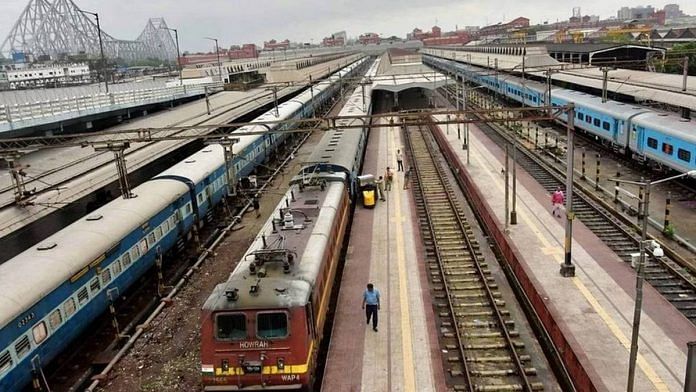New Delhi: To ensure safety of travelers, a parliamentary standing committee has asked the Ministry of Railways to ensure implementation of the indigenously designed train collision avoidance system, Kavach [shield], in all trains and tracks at the earliest.
The Standing Committee on Railways headed by Bharatiya Janata Party (BJP) MP Radha Mohan Singh also recommended “arranging funds” from the Rashtriya Rail Sanraksha Kosh (RRSK) — “established to strengthen safety measures on the rail network to prevent accidents” — to be used only for safety-related works, even as it highlighted a shortfall in allocation to this fund.
“The Committee would like to suggest to the Ministry to arrange funds from RRSK for providing indigenously designed train collision avoidance system — KAVACH — in entire rail network at the earliest for the safety of the railways and passengers,” the panel said in its 15th report, tabled in Parliament Tuesday. ThePrint has a copy of the report.
The Committee also pulled up the Ministry for “noticeable gap in funding to and expenditure from the RRSK” year after year.
A 2022 CAG report on ‘Derailment in Indian Railways’ highlighting misuse of the funds on non-priority items such as a foot massager had come into news in the aftermath of June’s Balasore train collision, to draw attention to underutilisation of the RRSK.
According to latest available government data, the kavach technology, developed at a cost of Rs 22 crore, covers only about two percent — or approximately 1,465 kilometres — of India’s 68,000-kilometre railway network. Union Railway Minister Ashwini Vaishnaw in a written response to Lok Sabha on 2 August, had said that kavach has been deployed on South Central Railway in Telangana (684 route kilometre), Andhra Pradesh (66 Rkm), Karnataka (117 Rkm) and Maharashtra (598 Rkm).
The Kavach technology is aimed at aiding loco pilots in running the train within specified speed limits, by automatically applying brakes in case of overspeeding in case loco pilots fail to do the same. This is because the system is equipped with a signal that uses ultra-high radio frequencies to control train brakes automatically.
The minister in his response had added that kavach tenders have been awarded for Delhi-Mumbai and Delhi-Howrah corridors (approximately 3000 Rkm (route kms)) and work is in progress on these routes in West Bengal (229 Rkm), Jharkhand (193 Rkm), Bihar (227 Rkm), Uttar Pradesh (943 Rkm), Delhi (30 Rkm), Haryana (81 Rkm), Rajasthan (425 Rkm), Madhya Pradesh (216 Rkm), Gujarat (526 Rkm), Maharashtra (84 Rkm).
Vaishnaw had noted that Indian Railways is preparing a detailed project report (DPR) and detailed estimate for another 6,000 RKm, adding that in the financial year 2023-24, the budgetary allocation for Kavach stood at Rs. 710.12 crores, and that a total of Rs. 351.91 crores has been spent so far on the implementation of the train collision avoidance system.
RRSK shortfall reflects badly on Railways
Noting that while the RRSK was created with a vision to have a single head in order to cater to all safety-related needs of the railways, the parliamentary panel in its report Tuesday added that railways did not meet the target of earmarked allocations during the past five years and “felt that since this fund had been created with an intended objective to cater to safety-related needs, such a shortfall reflects poorly on the ability of Indian Railways”.
The RRSK was created in 2017-18, for a period of five years for execution of safety-related works, including track renewals and signal and telecom works, with annual contribution of Rs 20,000 crore. Of this, Rs 15,000 crore was to come from Gross Budgetary Support (GBS) allocated to railways in the Union budget and Rs 5,000 crore from the railways’s internal resources. Prior to the inception of RRSK, all works of replacement and renewal were charged to the Depreciation Reserve Fund (DRF) of railways.
According to data shared in the report, for a five-year period between the 2017-18 financial year and the 2021-22 financial year, an expenditure of Rs. 74,444.18 crore was incurred from RRSK, which comprised of Rs. 70,000 crore from GBS and Rs 4,444.18 crore from the Railways’s internal resources. The RRSK’s currency has been extended for another five years, starting 2021-22 with a corpus of Rs 45,000 crore.
The panel’s report quoted the Railway Ministry as saying that it could not contribute the intended funds to RRSK owing to inadequate resource generation — which was impacted by the factors such as the impact of the Covid-19 pandemic on operations, higher traction cost and repayment of lease charges, among others — and non-availability of surplus funds for being deployed towards capital expenditure.
“Total social service obligations including pricing below cost was Rs 51,138 crore in [20]21-22. Railways have not been able to revise its fare and freight required for absorbing increase in cost, with a view to keep logistics cost low and help the marginal sections of society. This leads to reduction in Net Revenues impacting MoR’s ability to fund capex from internal generation,” the ministry added in its reply.
For RRSK, the government has made a provision of Rs 11,000 crore each in both revised estimates 2022-23 and budget estimates 2023-24, according to the report, with contribution from GBS being Rs. 10,000 crore and from Internal Resources of Rs. 1,000 crore.
“…all out efforts to be made by the Ministry of Railways for intended funding to RRSK, Railways are taking steps to increase net revenue so that adequate fund may be appropriated to RRSK from internal resources,” the ministry was quoted as saying.
(Edited by Poulomi Banerjee)
Also read: Indian Railways has 2.5 lakh-plus posts lying vacant, highest in northern zone, govt tells RS



